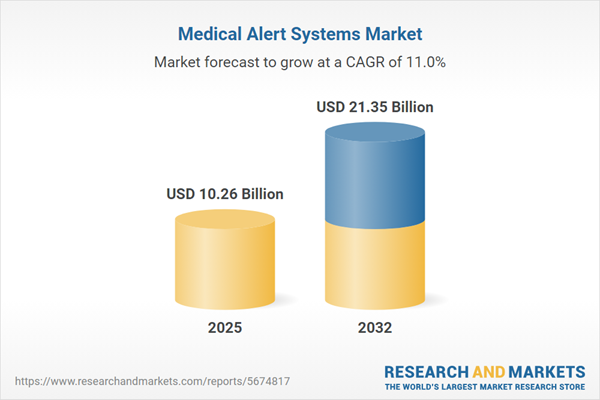Speak directly to the analyst to clarify any post sales queries you may have.
Medical alert systems are advancing the way organizations ensure safety for seniors and enhance continuous monitoring for individuals needing oversight. Market innovation is redefining standards of emergency response, user autonomy, and reliability for providers and users alike.
Market Snapshot: Medical Alert Systems Market Growth Overview
In 2024, the global medical alert systems market was valued at USD 9.23 billion. Forecasts show growth to USD 10.26 billion in 2025, at a compound annual growth rate (CAGR) of 11.04%. By 2032, the market is expected to surpass USD 21.35 billion. This growth trajectory highlights the rising adoption of medical alert devices in both healthcare institutions and private households. Driving factors include aging populations, a growing need for personal safety technology, and the emphasis on remote patient care. Organizations are turning to integrated, user-friendly, and highly adaptable solutions that can operate seamlessly in evolving care environments.
Scope & Segmentation: Medical Alert Systems
- Product Types: In-home consoles provide stable monitoring for residential users; mobile devices support remote and on-the-go emergency communication; wearable pendants and wristbands empower users with instant access to emergency alerts, improving user independence and safety outcomes.
- Service Models: Monitored systems deliver full-time professional oversight, providing peace of mind for organizations and families; self-monitored systems allow care recipients or caregivers to manage and customize alert features, encouraging flexibility in day-to-day management.
- Distribution Channels: Direct-to-consumer options allow individualized selection for home users, while institutional procurement offers scalable deployment to healthcare providers and long-term care facilities seeking to deploy consistent safety measures across larger populations.
- Technologies: Advanced fall detection algorithms enable quick and accurate identification of incidents; GPS tracking adds precise location support; two-way voice communication ensures immediate escalation and direct interaction during emergencies; both automated and manual alert features reinforce overall system reliability and foster stakeholder trust.
- End User Categories: Key user groups include residential care facilities aiming to implement effective safety protocols, seniors who prefer to age in place, and individuals managing chronic health issues who benefit from continuous oversight and swift response capabilities.
- Regions: North America and Europe benefit from robust regulatory compliance and established digital infrastructure; Asia-Pacific emphasizes scalable, cost-effective solutions to meet growing senior populations; South America is witnessing increased adoption due to healthcare modernization and evolving demographics.
- Leading Vendors: Notable market participants are Koninklijke Philips N.V., Bay Alarm Company, Life Alert Emergency Response, Medical Guardian, ADT Inc., MobileHelp, LifeFone, Connect America, GreatCall, and Tunstall Healthcare Group, all focused on refining their platforms to address operational diversity and innovation demands.
Key Takeaways for Senior Decision-Makers
- Diversifying device portfolios and strengthening connectivity drive operational stability, ensuring reliable implementation in single facilities or enterprise-wide deployments.
- Mobile and wearable solutions improve flexibility and engagement for care teams, supporting efficient response across multiple care settings and helping users remain active and independent.
- The inclusion of wellness monitoring tools supports preventative health management strategies, making it easier for providers to deliver long-term value to care recipients.
- Platforms with adaptable infrastructure enable customized installations and integration into existing workflows, accommodating complex operational and resource needs.
- Seamless compatibility with current healthcare technologies shortens staff onboarding cycles and mitigates disruptions during transition phases.
- Staying ahead of regulatory requirements inspires stakeholder confidence, helping organizations maintain stability when regulations or market dynamics shift.
Tariff Impact and Supply Chain Adaptation
The 2025 US tariff implementation increased pressure on manufacturers to form tighter relationships with domestic suppliers and pursue alternate procurement strategies. By broadening supplier bases, organizations are better insulated from pricing volatility and can swiftly respond to shifts in regulations. This approach secures steady access to essential medical alert devices for healthcare organizations and private buyers, reducing the risk of shortages or delays.
Methodology & Data Sources
Analysis for this market is based on primary interviews with industry executives and decision-makers. It is supported by regulatory reviews, sector reports from recognized industry bodies, and structured survey data. This approach ensures that the report presents strategic insights grounded in credible, diverse data sources for a comprehensive industry perspective.
Why This Report Matters: Senior Market Overview
- Delivers actionable intelligence for procurement managers and healthcare leaders to assess technology investments and regulatory compliance in medical alert systems.
- Clarifies strategic opportunities, helping organizations design responsive investment and operational plans across different care delivery environments.
- Sheds light on market adoption trends and evolving supply-chain models, enabling companies to maintain resilience in the face of regulatory or supply disruptions.
Conclusion
Investing in user-focused and integrated medical alert systems prepares organizations to address ongoing safety priorities and promote resilient, future-ready care operations for seniors and those requiring continuous supervision.
Additional Product Information:
- Purchase of this report includes 1 year online access with quarterly updates.
- This report can be updated on request. Please contact our Customer Experience team using the Ask a Question widget on our website.
Table of Contents
3. Executive Summary
4. Market Overview
7. Cumulative Impact of Artificial Intelligence 2025
Companies Mentioned
The companies profiled in this Medical Alert Systems market report include:- Koninklijke Philips N.V.
- Bay Alarm Company, Inc.
- Life Alert Emergency Response, Inc.
- Medical Guardian, LLC
- ADT Inc.
- MobileHelp, Inc.
- LifeFone, Inc.
- Connect America, Inc.
- GreatCall, Inc.
- Tunstall Healthcare Group Ltd.
Table Information
| Report Attribute | Details |
|---|---|
| No. of Pages | 189 |
| Published | October 2025 |
| Forecast Period | 2025 - 2032 |
| Estimated Market Value ( USD | $ 10.26 Billion |
| Forecasted Market Value ( USD | $ 21.35 Billion |
| Compound Annual Growth Rate | 11.0% |
| Regions Covered | Global |
| No. of Companies Mentioned | 11 |









